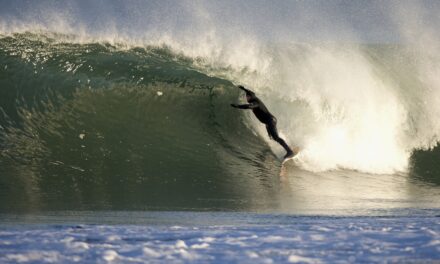Hurricane season officially begins on June 1 and ends on November 30 each year. The lists of hurricane names for each season are chosen by the World Meteorological Organization (not The Old Farmer’s Almanac). There are six lists of names for Atlantic and Pacific storms, which are cycled through every six years.
The lists have been maintained since 1953 (originally by the National Hurricane Center). For the 2022 hurricane season, the list of names from 2016 is being used again, so don’t be surprised if some sound familiar. Those that are not retired from the list this year will be used again in the 2028 season.

Balaram Stack spends a lot of time either at home or booking tickets back home when it’s Hurricane Season on the Right Coast. This is why. Bal finds safe harbor anchored deep in a hurricane hole during Hurricane Henri. Photo: Mike Nelson
The names of especially destructive hurricanes are usually retired and not used again. See a list of retired tropical storm and hurricane names here.
The list below include storms in both the Atlantic Basin meaning both the Gulf and East Coast hurricanes.

The Northeast has the nooks, crannies and angles to help tame long period swell that turn beach breaks from Long Island to Florida into nightmare paddling scenarios and closed out lines a mile long. Easy go out during Hurricane Larry. Photo: Josh Kelly @joshuakellyphotos
The 2020 Atlantic hurricane season was the most active Atlantic hurricane season on record—we ran through the entire alphabetical list of names (and then some)! This happens very rarely (it has only happened once before, in 2005), but seems likely to become more common. What happens when it does?
If more storms occur in one season than there are names on the list, the newest storms have traditionally been named after the Greek alphabet (Alpha, Beta, Gamma, etc.). However, starting in 2021, this was no longer the case. Instead of the Greek alphabet, a list of supplemental names is used. Like names from the regular annual lists, supplemental names can be retired and replaced if the storms are deemed to be significantly impactful.

Unidentified driving through the beautifully backlit, emerald green water at Manasquan, New Jersey during Hurricane Larry. Photo: Bruce Chrisner
The WMO decided to discontinue use of the Greek alphabet for several reasons, including:
- Using the Greek names was such a rare occurrence that it distracted from more important news about the hurricanes themselves.
- When translated into different languages of the region, the Greek names led to confusion and inconsistencies.
- The names Eta and Iota were retired after the 2020 season and there had not been a plan for replacing retired Greek names.
So, any extra storms will now be named from the supplemental names lists shown below. 
And not all potential systems get a name as evidenced with late 2022 season Invest 95. I-95 was a tropical blob if you will that dropped plenty of rain, kicked up blustery winds but fell just a tad short of earning a name while creating some great waves on the south side of Hatteras Island, NC. Photo: Mez
Other Notes Of Interest:
- Native Americans called these destructive storms hurakons, after “a great spirit who commanded the east wind.” Spanish explorers adopted the word and then began giving hurricanes the names of patron saints on whose feast days the storms occurred. Later, hurricanes were identified by their longitude and latitude.
- In 1950, a formal practice for storm naming was developed by the U.S. National Hurricane Center. At that time, storms were named according to a phonetic alphabet (e.g., Able, Baker, Charlie) and the names used were the same for each hurricane season; in other words, the first hurricane of a season was always named “Able,” the second “Baker,” and so on.
- In 1953, to avoid the repetitive use of names, the system was revised so that storms would be given female names. This mimicked the habits of old naval meteorologists, who named the storms after their wife or girlfriend, much the way ships at sea were named after women. A weatherman in Australia is credited with being the first person to give a tropical storm a female name.
- In 1979, the system was revised again to include both female and male names.

Luke Davis, New Smyrna during Hurricane Larry. Perhaps not the most exotic monicker for such a great wave producer but Larry’s name will no doubt be remembered for a very, very long time by Luke. Photo: Mez









